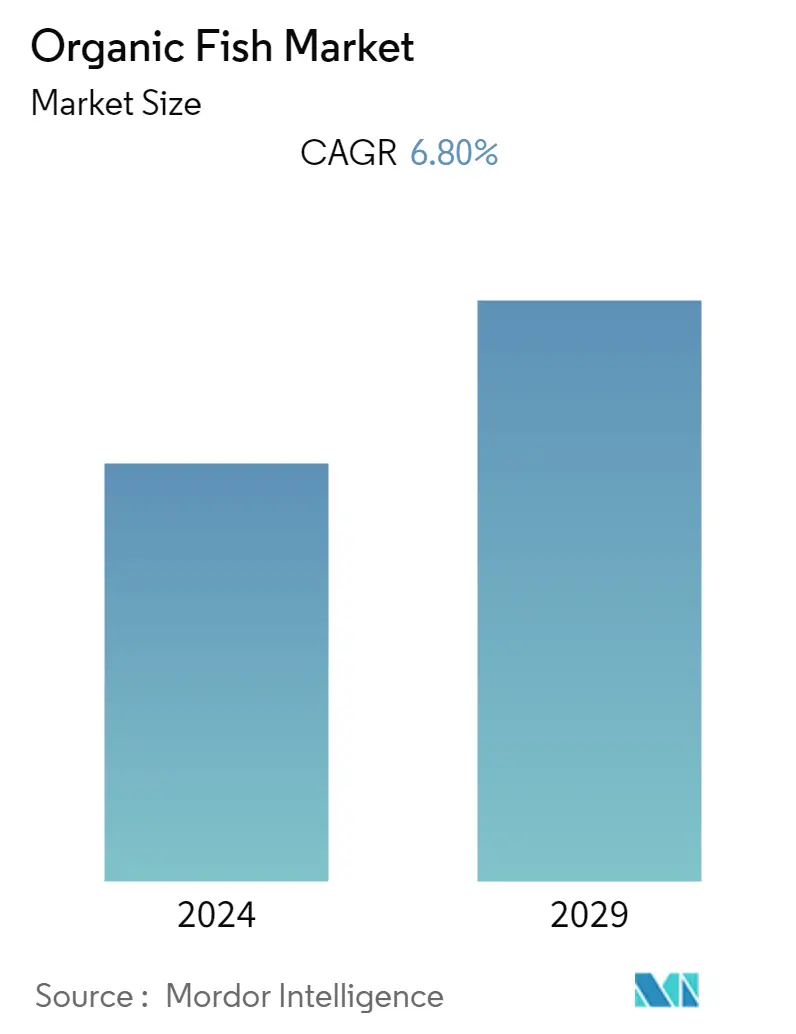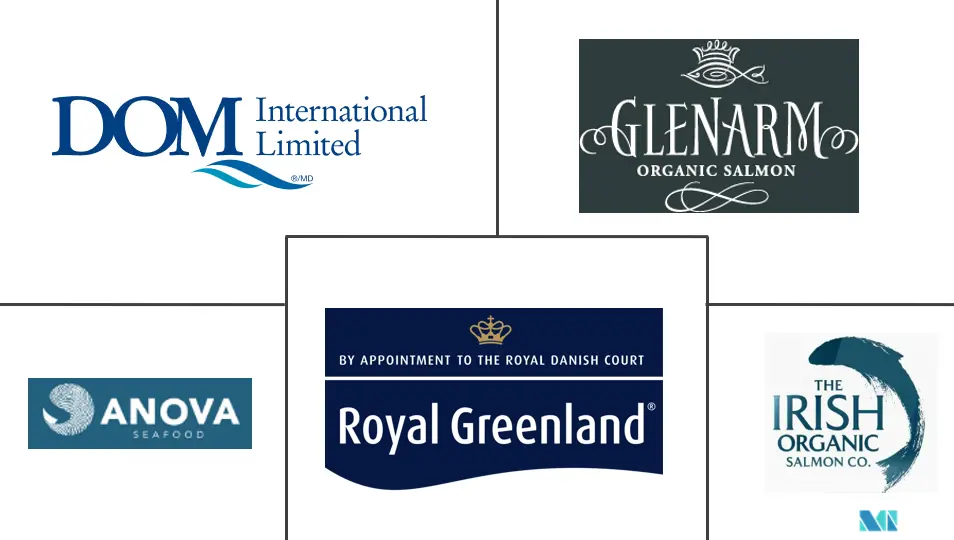Market Size of Organic Fish Industry

| Study Period | 2019 - 2029 |
| Base Year For Estimation | 2023 |
| CAGR | 6.80 % |
| Fastest Growing Market | Asia-Pacific |
| Largest Market | Asia-Pacific |
| Market Concentration | Low |
Major Players
*Disclaimer: Major Players sorted in no particular order |
Organic Fish Market Analysis
The organic fish market is projected to register a CAGR of 6.8% over the forecast period.
- The increasing adoption of organic farming by aquaculture farmers to improve productivity and nutritional content of products is positively influencing market growth. Furthermore, the shifting consumer preference for organic fish due to increased food-borne illnesses caused by pathogens such as salmonella and calicivirus found in conventionally cultured fish has increased product demand. Aside from that, there has been a significant shift from high-calorie foods to protein-rich diets due to increased awareness of their health benefits.
- Furthermore, the growing emphasis on sustainable development and rising consumer disposable incomes contribute to market growth. Moreover, governments in several countries are taking positive steps to encourage farmers to practice organic fish farming and, for example, starting campaigns to educate farmers about the benefits of organic farming.
- Other factors, including the growing health consciousness among consumers, easy availability of organic fish via online and offline retail channels, elevating sales of frozen organic fish products, and rapid growth in the food industry, are also anticipated to create a favorable market outlook.
Organic Fish Industry Segmentation
Organic fish is produced by organic aquaculture methods. It is grown without chemicals, such as human-made pesticides, antibiotics, fertilizers, and genetically modified organisms (GMOs).
The organic fish market is segmented by type, form, distribution channel, and geography. Based on the type, the market is segmented into salmon, tuna, and others. Based on the form, the market is segmented into fresh/chilled, frozen/canned, and processed. Based on the distribution channel, the market is segmented into on-trade and off-trade. Off-trade is further segmented into convenience/grocery stores and online retail stores. Based on geography, the market is segmented into North America, Europe, Asia-Pacific, South America, and Middle East&Africa).
The report offers market size and forecasts in value (USD million) for the above segments.
| Type | |
| Salmon | |
| Tuna | |
| Other Types |
| Form | |
| Fresh/Chilled | |
| Frozen/Canned | |
| Processed |
| Distribution Channel | ||||
| On-Trade | ||||
|
| Geography | |||||||||
| |||||||||
| |||||||||
| |||||||||
| |||||||||
|
Organic Fish Market Size Summary
The organic fish market is experiencing robust growth, driven by the increasing adoption of organic farming practices in aquaculture, which enhance productivity and nutritional value. Consumer preferences are shifting towards organic fish due to concerns over food-borne illnesses linked to conventionally farmed fish and a growing awareness of the health benefits of protein-rich diets. The market is further bolstered by the emphasis on sustainable development and rising disposable incomes, with governments promoting organic fish farming through educational campaigns. The availability of organic fish through various retail channels and the rising sales of frozen organic fish products also contribute to a positive market outlook.
Asia Pacific is a key region for the organic fish market, supported by developing economies and a strong cultural inclination towards fish-based cuisines. The region's urbanization and increasing disposable incomes, coupled with government initiatives, are expected to drive significant market growth. The fragmented market sees major players focusing on product development, mergers, acquisitions, and partnerships to enhance their market position. Innovations in product offerings, such as MOWI's launch of organic Scottish salmon, and sustainable packaging solutions by companies like Organic Sea Harvest, highlight the industry's commitment to growth and sustainability.
Organic Fish Market Size - Table of Contents
-
1. MARKET DYNAMICS
-
1.1 Market Drivers
-
1.2 Market Restraints
-
1.3 Porter's Five Forces Analysis
-
1.3.1 Bargaining Power of Suppliers
-
1.3.2 Bargaining Power of Buyers/Consumers
-
1.3.3 Threat of New Entrants
-
1.3.4 Threat of Substitute Products
-
1.3.5 Intensity of Competitive Rivalry
-
-
-
2. MARKET SEGMENTATION
-
2.1 Type
-
2.1.1 Salmon
-
2.1.2 Tuna
-
2.1.3 Other Types
-
-
2.2 Form
-
2.2.1 Fresh/Chilled
-
2.2.2 Frozen/Canned
-
2.2.3 Processed
-
-
2.3 Distribution Channel
-
2.3.1 On-Trade
-
2.3.2 Off-Trade
-
2.3.2.1 Convenience/Grocery Stores
-
2.3.2.2 Online Retail Stores
-
-
-
2.4 Geography
-
2.4.1 North America
-
2.4.1.1 United States
-
2.4.1.2 Canada
-
2.4.1.3 Mexico
-
2.4.1.4 Rest of North America
-
-
2.4.2 Europe
-
2.4.2.1 Spain
-
2.4.2.2 United Kingdom
-
2.4.2.3 Germany
-
2.4.2.4 France
-
2.4.2.5 Italy
-
2.4.2.6 Russia
-
2.4.2.7 Rest of Europe
-
-
2.4.3 Asia Pacific
-
2.4.3.1 China
-
2.4.3.2 Japan
-
2.4.3.3 India
-
2.4.3.4 Australia
-
2.4.3.5 Rest of Asia-Pacific
-
-
2.4.4 South America
-
2.4.4.1 Brazil
-
2.4.4.2 Argentina
-
2.4.4.3 Rest of South America
-
-
2.4.5 Middle East and Africa
-
2.4.5.1 South Africa
-
2.4.5.2 Saudi Arabia
-
2.4.5.3 Rest of Middle East and Africa
-
-
-
Organic Fish Market Size FAQs
What is the current Organic Fish Market size?
The Organic Fish Market is projected to register a CAGR of 6.80% during the forecast period (2024-2029)
Who are the key players in Organic Fish Market?
Anova Seafood B.V., Glenarm Organic Salmon Ltd., Royal Greenland A/S, The Irish Organic Salmon Co. and Dom International Limited are the major companies operating in the Organic Fish Market.

